A muddy river in a bigger picture
11/07/2019
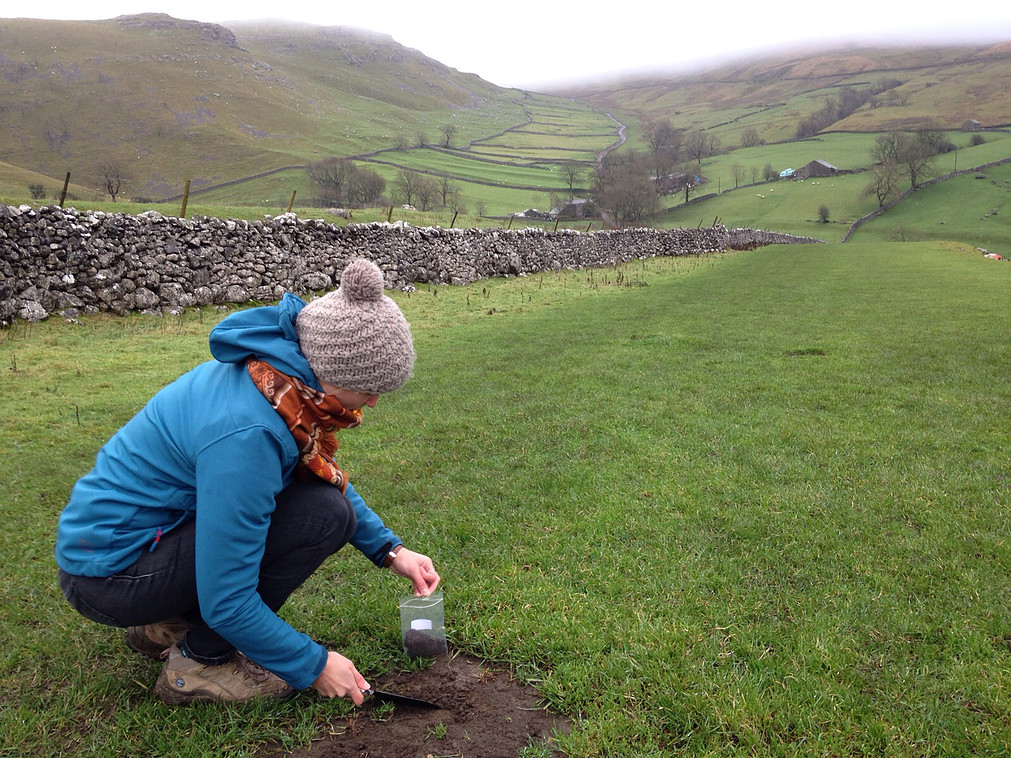
Two years ago I completed my PhD at Cranfield University. Now, after a postdoc at University of Leeds, I am back at Cranfield working on a NERC-funded project on social-economic-environmental trade-offs in managing the land-river interface. The start of my new job at Cranfield coincided with the publication of the last paper of my PhD, called “Temporal variation in suspended sediment transport: linking sediment sources and hydro-meteorological drivers”. So, before getting into the exciting details of the new project, let’s talk about sediment!
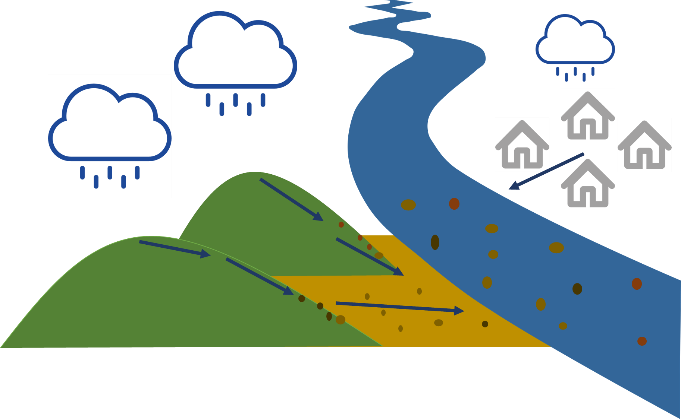
What do we mean by suspended sediment? Well, basically, when it rains and water falls onto the earth’s surface, it can cause very fine particles (from different surfaces, such as soils and streets) to be transported together with the flowing water towards the river. Once the particles are in the river, we call it sediment. Sediment is an important aspect of rivers, as these particles carry nutrients from the land and they form the building blocks of aquatic habitats. However, too much sediment can also cause problems to these habitats, and sediment particles are also known to carry pollutants. Therefore, scientists and river managers are very much interested in understanding sediment transport in rivers.
Let’s now zoom out a bit and look at an entire river catchment that consists of four types of land use (grassland, forest, agriculture, urban). Suppose it starts raining and particles are being transported from land towards the river from all across the catchment (situation 1). As a result of this, we get a mixture of sediment coming from the surface of the four types of land use. Alternatively, when it is only raining in the upper left part of the catchment, we get mainly particles from the grassland area (situation 2), while only rain in the right part of the catchment will mainly cause particles from forest and urban area to be transported to the river (situation 3).
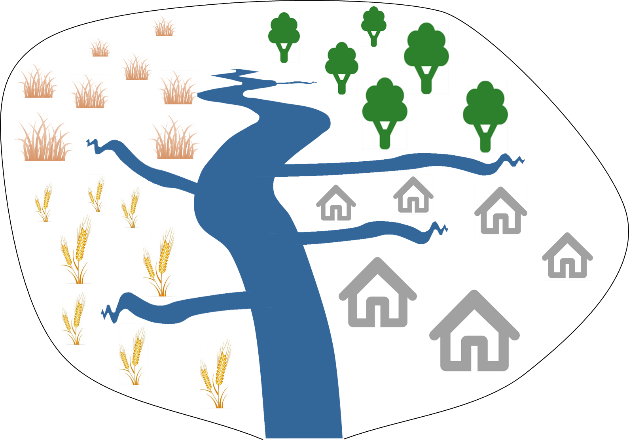
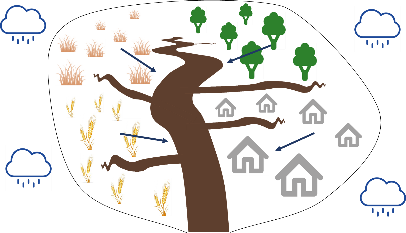

Situation 2: rainfall in upper left part of the catchment
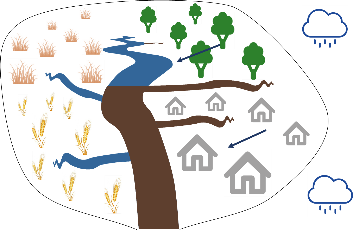
Situation 3: rainfall in right part of the catchment
In each of these three situations, the amount and source of the sediment will be different. However, if we take a sediment sample at the outlet of the river catchment in each of these situations, we can calculate how much sediment is in our sample, but we cannot actually see where the sediment comes from. From the mixed sediment sample, we simply cannot see what the main sources of the sediment are.
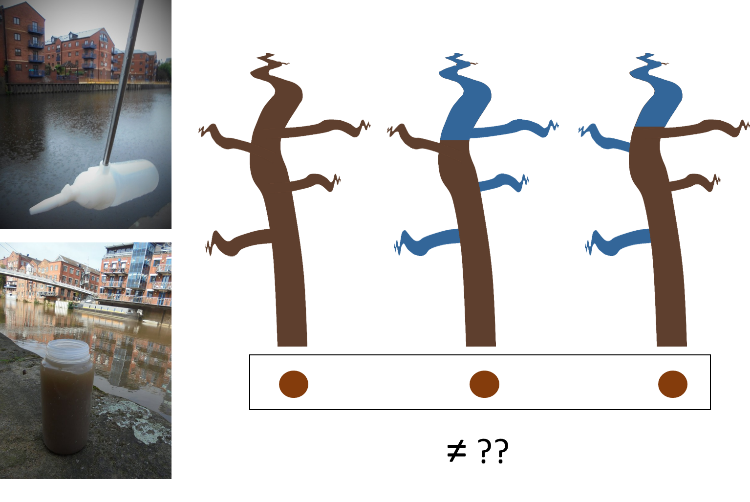
Why would we want to know the source of the sediment? Understanding how much sediment there is in the river, where it comes from, and how it varies over time as a result of variations in rainfall, provides very important information that can help us better predict and monitor fine sediment in rivers and develop targeted management strategies. But because sediment studies in rivers are based on the mixed sediment samples, we miss important information about the bigger picture (catchment).
That is why our recently published paper applied a technique called “sediment fingerprinting”, which basically aims at identifying the sources of sediment in a mixed sample. The technique characterises sediment from the different sources (land use types) (which we did using Infrared Spectroscopy), and then include these characteristics into a statistical model to “un-mix” our samples into the contributions of the sources.

Identifying the sediment fingerprint of each sediment source

Un-mixing sediment sample in contributions of sediment sources with statistical model
We applied this technique to the River Aire in Leeds (UK) to identify the most important sediment sources of fine sediment in the River Aire, and most importantly, investigate how these sources vary over time as a result of variations in rainfall and river flow. By linking information obtained through sediment fingerprinting with detailed rainfall and river discharge data, we were able to construct a bigger (sediment) picture for the River Aire catchment.
Categories & Tags:
Leave a comment on this post:
You might also like…
Preparing your work for Turnitin submission
Before submitting your work into Turnitin for similarity checking, if you have used referencing software then you may need to take some important steps first. Mendeley and Zotero integrate with MS Word by embedding field ...
The fast track to supercar engineering: My Cranfield journey
It’s been a dream come true to work on some of the world’s most prestigious supercars – the Aston Martin Valhalla, McLaren 750 & Artura, the GMA T.33. But every successful ...
Automotive Engineering: From student to hypercar innovation at Rimac
We sat down with recent graduate Thomas Perrin, to discuss how his year on the MSc in Automotive Engineering at Cranfield University propelled him from the lecture hall directly into the ...
What this year at Cranfield really meant to me
Every Cranfield journey is unique. In this alumni reflection, Zachea Scicluna shares what her year at Cranfield truly meant, from facing uncertainty to gaining hands-on experience in industry-backed projects. I’ve been reflecting (and delaying) ...
Preparing for assignments and exams?
Sorry! We know it seems a bit mean to mention the exams in January rather than looking forward to the break before it! However, we know many of you will be thinking about your forthcoming ...
Screening for FTSE 100 companies on Bloomberg
So you’re researching an index and need some data on its constituent companies? Bloomberg’s Equity Screening tool makes light work of this, not just for the FTSE, but for indices, exchanges and sectors worldwide. Type EQS ...






